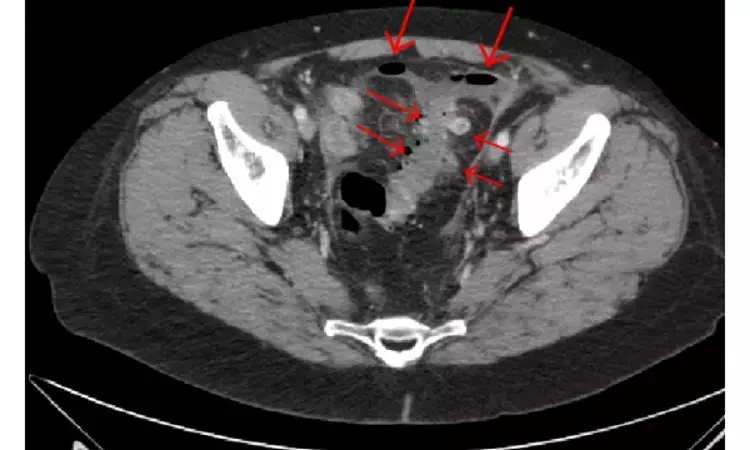- Home
- Medical news & Guidelines
- Anesthesiology
- Cardiology and CTVS
- Critical Care
- Dentistry
- Dermatology
- Diabetes and Endocrinology
- ENT
- Gastroenterology
- Medicine
- Nephrology
- Neurology
- Obstretics-Gynaecology
- Oncology
- Ophthalmology
- Orthopaedics
- Pediatrics-Neonatology
- Psychiatry
- Pulmonology
- Radiology
- Surgery
- Urology
- Laboratory Medicine
- Diet
- Nursing
- Paramedical
- Physiotherapy
- Health news
- Fact Check
- Bone Health Fact Check
- Brain Health Fact Check
- Cancer Related Fact Check
- Child Care Fact Check
- Dental and oral health fact check
- Diabetes and metabolic health fact check
- Diet and Nutrition Fact Check
- Eye and ENT Care Fact Check
- Fitness fact check
- Gut health fact check
- Heart health fact check
- Kidney health fact check
- Medical education fact check
- Men's health fact check
- Respiratory fact check
- Skin and hair care fact check
- Vaccine and Immunization fact check
- Women's health fact check
- AYUSH
- State News
- Andaman and Nicobar Islands
- Andhra Pradesh
- Arunachal Pradesh
- Assam
- Bihar
- Chandigarh
- Chattisgarh
- Dadra and Nagar Haveli
- Daman and Diu
- Delhi
- Goa
- Gujarat
- Haryana
- Himachal Pradesh
- Jammu & Kashmir
- Jharkhand
- Karnataka
- Kerala
- Ladakh
- Lakshadweep
- Madhya Pradesh
- Maharashtra
- Manipur
- Meghalaya
- Mizoram
- Nagaland
- Odisha
- Puducherry
- Punjab
- Rajasthan
- Sikkim
- Tamil Nadu
- Telangana
- Tripura
- Uttar Pradesh
- Uttrakhand
- West Bengal
- Medical Education
- Industry
Hartmann's procedure viable option for high-risk patients with perforated acute diverticulitis

Hartmann's procedure viable option for high-risk patients with perforated acute diverticulitis suggests a new study published in the Surgery
Hartmann’s procedure is a treatment option for perforated acute diverticulitis, especially when organ dysfunction(s) are present. Its use has been criticized mostly out of fear of high permanent stoma rate. The aim of this study was to investigate the rate of stoma reversal, reasons behind nonreversal, and safety of reversal surgery.
This was a single-center retrospective study of patients undergoing urgent Hartmann’s procedure due to acute diverticulitis between the years 2006 and 2017 with follow-up until March 2021.
Results
A total of 3,319 episodes of diverticulitis in 2,932 patients were screened. The Hartmann’s procedure was performed on 218 patients, of whom 157 (72%) had peritonitis (48 (22%) with organ dysfunction). At 2-years, 76 (34.9%) patients had died with stoma, 42 (19.3%) were alive with stoma, and 100 (45.9%) had undergone stoma reversal. The survival of patients with and without reversal were 100% and 42.7% at 1-year, 96.0% and 35.0% at 2-years and 88.9% and 20.7% at 5-years, respectively. The risk factors for nonreversal were old age, a need for outside assistance, low HElsinki Staging for Acute Diverticulitis stage, and higher C-reactive protein level upon hospital admission. The most common reasons for nonreversal in surviving patients were patient not willing to have the operation 18 (41%) and dementia 10 (23%). Twelve (12%) patients had a major complication after reversal (Clavien-Dindo IIIb–IV) and 90-day mortality after reversal was 0%.
After the Hartmann’s procedure for acute diverticulitis, one-third died, half underwent stoma reversal, and one-fifth did not undergo stoma reversal within 2 years. Patients who survive with stoma are either not willing to have reversal or have severe comorbidities excluding elective surgery. The Hartmann’s procedure remains a viable option for high-risk patients with perforated acute diverticulitis.
Reference:
Johannes M. Salusjärvi, Laura E. Koskenvuo, Juha P. Mali, Panu J. Mentula, Ari K. Leppäniemi, Ville J. Sallinen. Stoma reversal after Hartmann's procedure for acute diverticulitis,Surgery,Volume 173, Issue 4,2023,Pages 920-926, ISSN 0039-6060,
https://doi.org/10.1016/j.surg.2022.10.028.
(https://www.sciencedirect.com/science/article/pii/S0039606022009333)
Keywords:
Hartmann’s, procedure, viable, option, high-risk, patients, perforated, acute, diverticulitis, Surgery, Johannes M. Salusjärvi, Laura E. Koskenvuo, Juha P. Mali, Panu J. Mentula, Ari K. Leppäniemi, Ville J. Sallinen.
Dr. Shravani Dali has completed her BDS from Pravara institute of medical sciences, loni. Following which she extensively worked in the healthcare sector for 2+ years. She has been actively involved in writing blogs in field of health and wellness. Currently she is pursuing her Masters of public health-health administration from Tata institute of social sciences. She can be contacted at editorial@medicaldialogues.in.
Dr Kamal Kant Kohli-MBBS, DTCD- a chest specialist with more than 30 years of practice and a flair for writing clinical articles, Dr Kamal Kant Kohli joined Medical Dialogues as a Chief Editor of Medical News. Besides writing articles, as an editor, he proofreads and verifies all the medical content published on Medical Dialogues including those coming from journals, studies,medical conferences,guidelines etc. Email: drkohli@medicaldialogues.in. Contact no. 011-43720751


